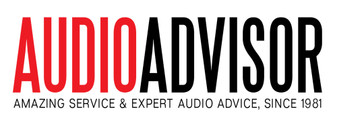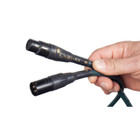An Affordable Cable with Matched Propagation Conductors
Parsec interconnect from Cardas Audio is the successor to the legendary Quadlink, delivering the familiar warmth and musicality of Quadlink, but with better imaging, transparency and dynamics. Parsec is also much more flexible than Quadlink, thanks to its TPR jacket.
Parsec is the first Cardas interconnect in the Cross product line to feature Matched Propagation Conductors, the technology originally developed for Clear. Parsec has a .370" outer diameter and uses a PFA and airtube dielectric. It uses shielded, Golden Ratio-scaled stranding, Pure Copper litz, Matched Propagation conductors.
Parsec interconnect is terminated with Cardas GRMO RCA connectors or Neutrik XLR plugs.
Overcoming the Dielectric Problem
One problem with standard audio cable designs is that the cable dielectric (also known as cable insulation) produces an electrical effect that interferes with the audio signal. While there is no current flow in dielectric materials, the dielectric accumulates and releases an electrical charge in response to the current flow in the conductor, much like the charging and discharging of a capacitor. But the electrical discharge from the dielectric is out of sync with the electrical signal in the conductor.
While the electrical signal in the conductor moves at the speed of light, the charge propagation in dielectric material is limited to approximately 78 percent of the speed of light. The discharge of the dielectric lags behind the charge in the conductor, causing a smearing of low-level information in the cable.
The Lagging Charge Problem
At very high frequencies, cables can appear to propagate faster because the slower dielectric materials don't have the time to charge at very high frequencies, and the lag is diminished.
At audio frequencies, however, this lag creates a noticeable problem. That's why dielectric manufacturers may brag about what their dielectrics will do at a million cycles per second, but don't talk about what they do at a thousand cycles per second, where the negative effects are audible. Jitter is one directly observable artifact of this conductor/dielectric relationship.
Some cable manufacturers try to compensate for this differential lagging in a cable by adding an electrical network (for example, by using a load coil), but the damage has already been done. Once the low level information in the signal has been smeared, it is lost and cannot be recovered.
The Matched Propagation Solution
Since the so-called 'charge propagation velocity' of the dielectric can never equal the speed of electrical changes in the conductors, George Cardas' ingenious solution is to slow the conductor to match the rate of the dielectric.
In a concentrically stranded conductor with individually coated strands (such as the constant "Q" conductor used in Cardas cables) the vector velocity and decay time of the conductor can be matched to that of the dielectric by controlling the lay length progression (twists per inch or TPI) of successive strand layers.
A matched propagation velocity conductor of this type mitigates the effects of capacitance much as a load coils do, but it does this continuously in the cable rather than at intervals. Eliminating the time delay between storage elements in the cable itself eliminates the bandwidth and dynamic range limitation seen in periodically loaded cables.
Cardas Matched Propagation Conductors maintain low level information and natural transients in a way that no other cable can. It does not exaggerate the leading edge of the signals or smear low-level information as conventional conductors do.
“A Short History of Audio Cable” by George Cardas (4mb PDF) ![]()
“Dielectric Propagation Velocity” by George Cardas (120k PDF) ![]()





















